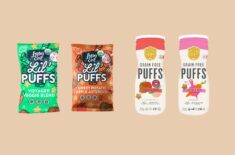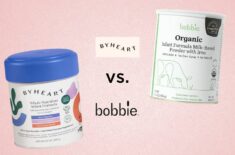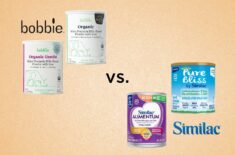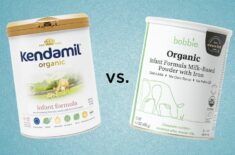Overview
You may have heard that tomatoes are allergenic, acidic, and can cause diaper rash. But if you browse through most grocery store shelves, you’ll likely notice that a lot of baby food is made with tomatoes.
So, which is it? Are tomatoes safe for babies or not?
If you’re taking the baby-led weaning approach and planning to serve tomatoes as finger food, you’re in for a treat because we’ll be listing ways to prepare, cook, and serve this delicious fruit in more ways than one.
We’re also going to discuss the safety of feeding your little one tomatoes in their first year and how to cut and prepare tomatoes according to your baby’s age. We’ll also talk about proper preparation, storage, and more.
What’s BLW?
First things first, what’s BLW (baby-led weaning)? According to Dr. Gill Rapley, baby-led weaning is a self-feeding approach where your child feeds themselves with the healthy food choices that you prepared. (1)
Can A 6-Month-Old Have Tomato?
According to the AAP (The American Academy of Pediatrics), a child can begin eating solid foods at six months of age, provided they’re showing signs of readiness. And, believe it or not, your baby’s first foods can include foods like meat or other proteins, grains, fruits, vegetables, yogurts, cheeses, and more. (2) (3)
Top Reasons To Serve Tomatoes In BLW
Although there are various valid concerns about including tomatoes in your baby’s meals, the health benefits of tomatoes can’t be ignored. We’ll address common fears such as choking hazards, allergic reactions, and acidity levels in the coming sections, so let’s first cover all the reasons to love this fruit. (4) (5)
Nutrition Facts & Health Benefits of Tomatoes
Here’s a list of vitamins and minerals in tomatoes: (6)
- The antioxidant lycopene – widely known to reduce the risk of heart disease and even cancer (7)
- Vitamin C – for boosting the immune system and aiding in iron absorption from both animal-based and plant-based sources like lentils (8)
- Vitamin A – supports your child’s developing eyesight (9)
- Vitamin K – promotes healthy bones (10)
- Fiber – helps regulate your baby’s bowel movement
- Iron – aids in your child’s growth and development (11)
- Potassium – helps regulate blood pressure (12)
Food Safety With Tomatoes
Is Tomato A Choking Hazard?
Due to their small and round shapes, cherry and grape tomatoes are particularly choking hazards. (4)
If you’re serving tomatoes in BLW, make sure to choose ripe tomatoes and slice them in large wedges, or if you’re serving grape or cherry tomatoes, crush them or slice them into small pieces.
Is Tomato An Allergen?
Tomato allergy is uncommon, although the acids found in tomatoes can cause a minor and often harmless skin rash. (13)
- Those with Oral Allergy Syndrome may be sensitive to the high acidity levels of tomatoes and may experience itching in the mouth. Serving cooked tomatoes may reduce the chance of having oral allergy symptoms. (5) (14)
- Diaper rash after consuming tomatoes has also been reported. According to Dr. Mona Gohara, MD, tomatoes and tomato-based products are highly acidic and can worsen the symptoms of diaper rash. (15)
- Tomato, melon, watermelon, orange, cherry, and rice are also associated with grass pollen allergies. (16)
Signs Of Allergic Reactions To Watch Out For
- Gastrointestinal problems
- Acid reflux
- Heartburn
- Indigestion
- Abdominal pain
- Cramps or vomiting
- Diarrhea
- Headaches
- Burning sensation or tightness of the skin
- Swelling
- Hives
- Tingling lips
- Rashes, Rosacea, dermatitis, perioral dermatitis
- Oral allergy syndrome
- Rhinitis or asthma-like symptoms
- Tightening of the chest
- Difficulty breathing
- Dizziness
- Painful joints
- Either cause or exacerbate the arthritic condition
Tomato pollen may also trigger rhinitis and/or conjunctivitis. Severe tomato allergy can cause anaphylactic shock. (17)
Consulting your baby’s pediatrician is still best when symptoms of food allergies occur.
As always, introduce a single new food in small amounts to easily observe any adverse reaction.
Food Safety Risks With Tomatoes
It’s a good idea to purchase organic tomatoes as tomato plants are typically treated with pesticides. High levels of pesticide residues on food can have both acute and chronic health effects. (18)
Peeling or thoroughly washing fresh tomatoes can help reduce these risks. (19)
Why Can’t Babies Have Tomatoes?
The high acidity levels of tomatoes can cause itching in the mouth and diaper rash. Cooking tomatoes may lessen the acidity and be more gentle on your baby’s tummy. (5) (14)
How to Serve Tomatoes In BLW
There are various ways to serve tomatoes to your child, depending on your baby’s age, readiness, and ability to chew and swallow foods.
Should You Peel Tomatoes Or Not?
4 Benefits of Peeling Tomatoes:
- Makes it easier to digest. Some babies may not digest tomato skin well. The peel might also be a choking hazard.
- Prevents gagging. Loose tomato skins may cause mild gagging.
- Avoids extra waxes. Although the FDA (Food & Drug Administration) has approved the waxing or coating of fruits and veggies, it’s still best to avoid serving waxed foods to your baby. (20)
- Removes pesticide residues. (21)
Tip: If you’re concerned about losing essential nutrients by peeling tomatoes, you can serve peeled tomatoes at first, then serve it unpeeled once you are confident that there are no adverse effects on your baby.
4 Easy Ways To Peel Tomatoes
- Blanching. Wash, remove the stems, cut an “X” on the bottom of the tomatoes, then boil. Cool the tomatoes before pulling on the loose skin.
- Roasting. Wash, remove the core, cut lengthwise, place the cut side down on a lightly oiled baking sheet, then bake at 425°F for 30-35 minutes or until the skins are split and charred.
- Broiling. Wash, remove the core, cut lengthwise, broil for 8-12 minutes or until the skins are split and charred.
- Freezing. Wash, dry, remove cores, then place tomatoes on a cookie sheet (make sure they don’t touch) before putting it into the freezer. Transfer frozen tomatoes to a freezer bag, then seal. Run it under warm water to easily remove the skins.
Note: Once sealed in an airtight container, frozen tomatoes can last up to 8 months. (22)
If you choose to keep the tomato peel when preparing this nutritious food for your baby, thoroughly wash and scrub the skin with water for at least 20 minutes. Research shows that the longer you wash fruits and vegetables with water, the more pesticide residues you can remove. (23)
Should You Serve Tomatoes Cooked Or Raw?
Cooked:
Fun Fact: Did you know that your baby’s body can absorb lycopene more easily from cooked tomatoes than from raw? (24)
Smooth tomato purees or mashes without the skin are good starting points when introducing tomatoes into your baby’s diet. (2)
You can also try making homemade tomato sauce, stews, soups, and incorporating tomatoes into meat dishes, pastas, and other family favorites.
Tip: Try serving tomatoes with fatty foods like olive oil, avocado, or fish like tuna and salmon. This is because the lycopene found in tomatoes is fat-soluble. Meaning it gets easily absorbed into the body when consumed with healthy fats. (25)
Raw:
Slicing ripe tomatoes and serving them in large wedges makes it easier for your little one to grab and munch on.
Cooking diminishes the vitamin C found in tomatoes. (25)
How Do You Cut Tomatoes For Baby-Led Weaning?
How Do I Prepare Tomatoes For My 6-Month-Old?
Prepare tomatoes by slicing them into large wedges your baby can easily hold. You can also serve tomato sauce, soups, or purees at first.
Remember that raw tomatoes contain acidic juice that can cause a mild skin rash, so serving cooked tomato may be best if this bothers your baby. In addition, cooking tomatoes may lessen the acidity and be more gentle on your baby’s tummy at this age. (5) (14)
How Do I Prepare Tomatoes For 9-12 Months Old?
You can be more adventurous and try serving sliced tomatoes or quartered grape or cherry tomatoes. If your child has already developed the pincer grasp, they can easily grab it as finger food, or it can be a good practice with a pre-loaded fork.
How Do I Prepare Tomatoes For 12+ Months Old?
You can start introducing salads and eating cut-up tomatoes along with other crunchy fruits and vegetables. Putting tomatoes in a sauce or adding them to a spread for dipping can be a fun addition to mealtime.
How To Choose And Store Tomatoes For Baby Food
When buying tomatoes for homemade baby food, choose fresh (organic if possible). Look for tomatoes with:
- Unbruised or unblemished skin
- Bright red color
- Firm but not hard texture
- Purchase the ones that are still on their vines as they will remain fresh for longer
Tip: To increase their shelf life, store tomatoes upside down (with their stem on the bottom) at room temperature. (27)
2 Quick & Yummy Baby Food Recipes With Tomatoes
Simple Tomato Omelet – Heat 1 teaspoon olive oil or ghee in a frying pan over medium heat, then add a handful of quartered grape or cherry tomatoes and sautee until softened. Pour in two beaten eggs, then sprinkle with the cheese of your choice. Skip this last part if your baby has a dairy allergy. Let it cool, then cut into wedges or small pieces, about two fingers’ width thick.
Note: For BLW, your baby can easily self-feed by using a spoon or their hands.
Tomato & Mozzarella Salad – Salad time! This recipe needs one medium to large beefsteak tomato, a ball of fresh mozzarella (4.4 oz), one basil leaf, and one teaspoon of olive oil. Peel the tomato and slice it into strips. Add the sliced mozzarella, then pour the olive oil and basil. Mix to combine all ingredients, then serve.
Other Foods Good To Incorporate With Tomatoes
REFERENCES
(1) http://rapleyweaning.com/assets/Defining_BLW_v2.pdf
(2) https://www.healthychildren.org/English/ages-stages/baby/feeding-nutrition/Pages/Starting-Solid-Foods.aspx
(3) https://www.cdc.gov/nutrition/infantandtoddlernutrition/foods-and-drinks/when-to-introduce-solid-foods.html
(4) https://www.cdc.gov/nutrition/infantandtoddlernutrition/foods-and-drinks/choking-hazards.html
(5) https://pubmed.ncbi.nlm.nih.gov/29336286/
(6) https://fdc.nal.usda.gov/fdc-app.html#/food-details/170457/nutrients
(7) https://www.mskcc.org/cancer-care/integrative-medicine/herbs/lycopene
(8) https://pubmed.ncbi.nlm.nih.gov/6940487/
(9) https://ods.od.nih.gov/factsheets/VitaminA-Consumer
(10) https://ods.od.nih.gov/factsheets/VitaminK-Consumer/
(11) https://ods.od.nih.gov/factsheets/Iron-Consumer/
(12) https://ods.od.nih.gov/factsheets/Potassium-Consumer/
(13) https://pubmed.ncbi.nlm.nih.gov/22860619/
(14) https://www.aafp.org/afp/2008/0615/p1678.html
(15) https://www.parents.com/baby/care/skin/food-allergies-and-your-babys-skin/
(16) https://acaai.org/allergies/allergic-conditions/food/pollen-food-allergy-syndrome/
(17) https://www.allergylink.co.uk/allergy-blog/2016/10/26/tomato-allergy-and-related-symptoms/
(18) https://www.who.int/news-room/fact-sheets/detail/pesticide-residues-in-food
(19) https://www.scielo.br/j/jbchs/a/3hRZdgkbM9H3FqRBrWnD9Mq/?lang=en#:~:text=In%20summary%2C%20washing%20with%20water,reduced%20consumer%20exposure%20to%20pesticides.
(20) https://www.fda.gov/regulatory-information/search-fda-guidance-documents/cpg-sec-562550-safety-and-labeling-waxed-coated-fruits-and-vegetables
(21) https://www.ncbi.nlm.nih.gov/pmc/articles/PMC3907644/
(22) https://food.unl.edu/article/freezing-tomatoes
(23) https://www.ncbi.nlm.nih.gov/pmc/articles/PMC6388112/
(24) https://news.cornell.edu/stories/2002/04/cooking-tomatoes-boosts-disease-fighting-power
(25) https://www.ncbi.nlm.nih.gov/pmc/articles/PMC3850026/
(26) https://www.floridatomatoes.org/news-events/10-reasons-why-you-should-be-eating-more-tomatoes/
(27) https://www.kqed.org/bayareabites/50006/how-to-buy-and-store-fresh-tomatoes












